Posted: February 10th, 2011 | No Comments »
A fascinating series of posts and articles on the Americans in Chungking in the 1940s and what they may or may not have got up to while there including the possibility that they organised a camp to detain, torture and kill Chinese communists. I don’t know the author of these pieces but they do appear to require a closer reading to sort out the sources.
Anyway, they’re all here
Posted: February 10th, 2011 | 1 Comment »
I confess to having been asked to add a blurb to back cover of this book – Forgotten Souls: A Social History of Hong Kong Cemetery – and after reading it was happy to. Patricia Lim has gathered together a real wealth of stories about the 10,000 or so ‘inhabitants’ of Hong Kong Cemetery and weaved it all around a great series of anecdotes. Put by the bedside for a browse each evening before sleeping – excellent for those final thoughts of the day that spur good dreams! As ever blurb below:

- Follows on from the mapping and recording of the about 10,000 graves dating from 1842 up to the present day that make up the Hong Kong Cemetery for a database.
– Breathes life into the stories behind the gravestones, telling who these long-buried people were and how they lived their lives.
-Â Should appeal to those interested in Hong Kong’s roots as well as those studying history or genealogy and find that cemeteries hold a unique and fascinating importance as sources for their studies.
Patricia Lim has lived in Hong Kong for more than thirty years.
Posted: February 10th, 2011 | No Comments »
The other day I noted and praised Taipei’s Huashan 1914 Creative Park in an old brewery complex in central Taipei. One additional attraction of Huashan 1914 is ‘NPM Digital’, an exhibition put together by the National Palace Museum of various digital art pieces. It’s interesting for a number of reasons, quite apart from that it’s great to see the NPM getting involved in this sort of thing.
First of the displays are excellent. Huang Hsin-Chien’s The Taste of Daily Life exhibit features three actual Song Dynasty porcelain vases from the NPM with interactive images superimposed over them of petals falling, rain clouds dispersing, rain falling etc etc – visitors blow through tubes to activate the images and the result is rather magical. There’s also some 3-D cartoons that grabbed the little kid’s attention and (rather worryingly this is quite common I note these days) quite a few adults too. However, a giant screen with sort of iPad technology features several Qing masterpieces including the Italian artist, who trained in the Chinese style, Giuseppe Castiglione’s (Lang Shining) One Hundred Horses (below) The large screen and touch-screen technology allows you to move across the image, zoom in and really examine the detail and brushstroke. I was amazed…and even more amazed when the 10 year old beside me who had moaned about entering the exhibit then spent the next 40 minutes playing on the screen and marvelling at the details he could find. How’s that for middle class parenting!!
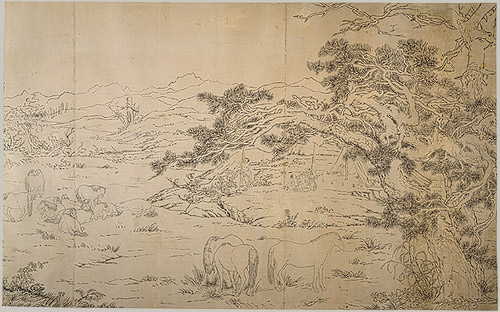
The second reason to visit NPM Digital is that it is housed in the old brewery’s former boiler room constructed in 1931 and you can see some of the old cooling pipes still in place plus the graffiti added in when the brewery was derelict for many years.
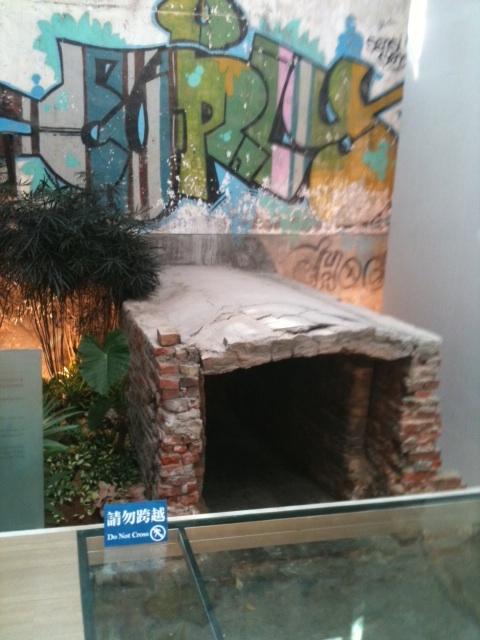 This is the inlet from outside into the former boiler room, now the NPM Digital exhibit space at Huashan 1914 Creative Park
This is the inlet from outside into the former boiler room, now the NPM Digital exhibit space at Huashan 1914 Creative Park
Posted: February 9th, 2011 | 6 Comments »
I noted in a previous post the loss of a major block alongside the banks of Suzhou Creek and the bulldozing of perfectly refurbishable lilongs and shikumen along Fujian Road North (Fokien Road North) that had been left to rot for several years to allow for demolition. This Google Earth image, I think, shows just how much was cleared on this plot and how vulnerable the blocks (constructed between 1927-31) fronting onto Zhejiang Road North (Chekiang Road North) are now.
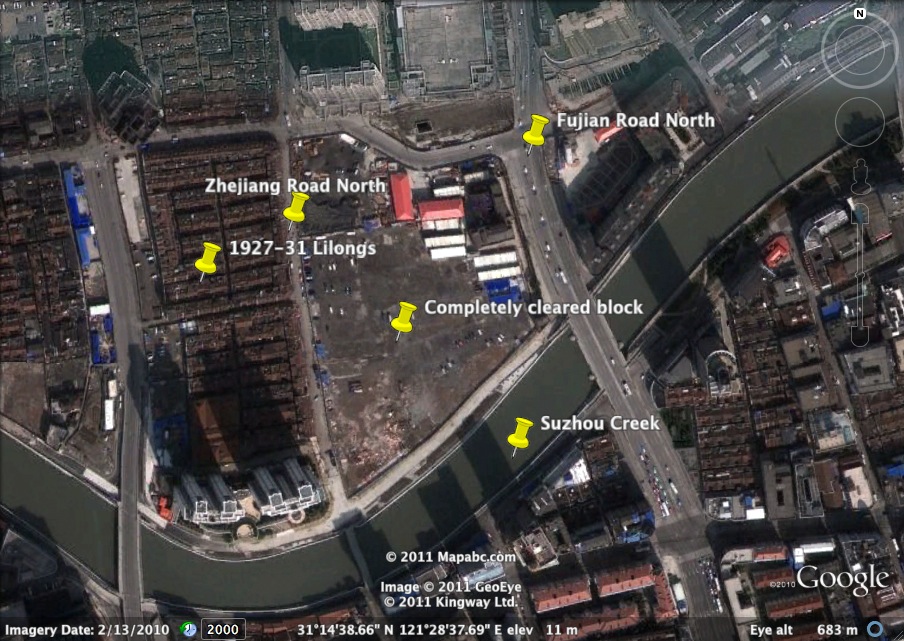
Posted: February 9th, 2011 | No Comments »
Were I in Peking on Tuesday February 15th I’d be popping along to this to have a look-see for anything I might have missed in the past.
Beijing Bookworm
Tuesday 15 February
Maps from the archives, presented by Beijing Postcards
7.30pm – 20/30rmb
Beijing Postcards opens up their archives to bring us some of their most fascinating maps depicting Beijing and China over the centuries.
Beijing Postcards – http://www.beijing-postcards.com/
Beijing Bookworm – http://www.beijingbookworm.com/
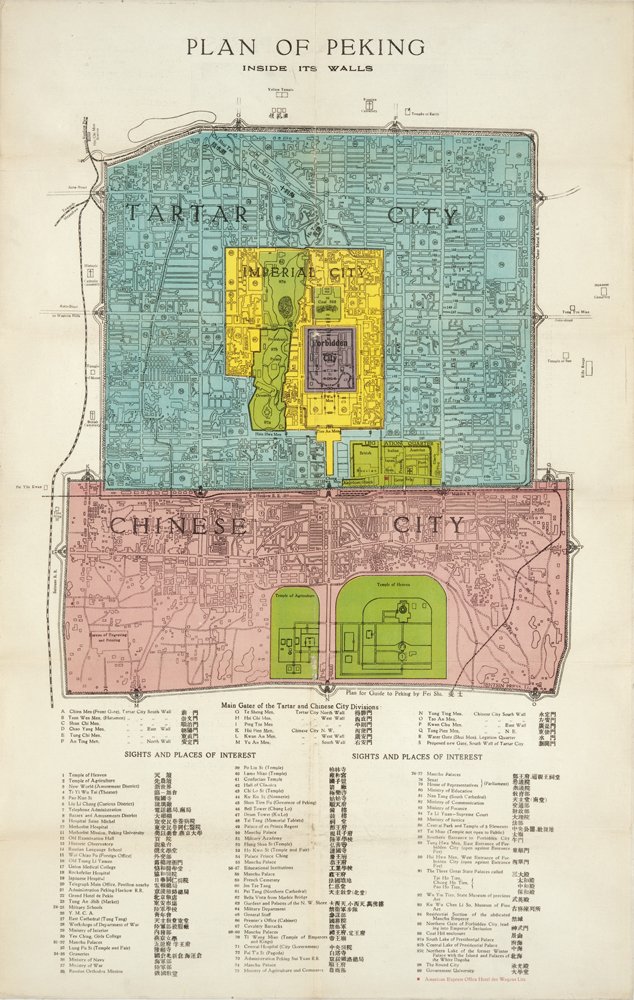
Posted: February 9th, 2011 | 1 Comment »
According to the China Daily:
“Liu Qi, secretary of Beijing Municipal Party committee, said Beijing government on Jan. 16 would try its best to preserve the appearance of an ancient capital, and in particular it aims to pay much more attention to protecting and planning around the city center as it tries to apply for U.N. World Culture Heritage…”
The words better, late, than and never spring to mind
According to the newspaper this would cover the following: an area of 7.8 kilometers from the Yongding Gate (pictured below) to the Bell Tower including the Bell Tower itself, Prince Gong’s Mansion, the Royal City’s wall, the Forbidden City, the Imperial Ancestral Temple and, wait for it and unsurprisingly, Zhongnanhai (the heavily guarded leadership enclave).
This follows long running worries about the Drum and Bell Tower (see here) where preservationists have already seen some hutong bulldozed and tried to oppose a plan to redevelop more of the area. The government got a bit touchy about that, protest meetings etc etc were cancelled.
So we shall see what happens with the long overdue application to the UN – one fear must be that th corrupt and the property developers will get in and do as much damage as possible prior to any UN Heritage status being awarded.
Also note that this ‘zone’ does not include a large number of threatened hutong across the city including around Jinbao Jie, near Wangfujing, behind Beijing Railway Station, towards the Summer Palace and other locations.
Still we can but hope…
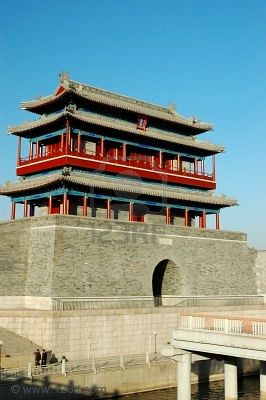
Posted: February 8th, 2011 | No Comments »
An interesting new book out – Richard Wolin’s The Wind From the East which describes two of the weirdest things in the twentieth century – China’s Cultural Revolution and the arrogance of French intellectuals! However, a surprising number of French intellectuals (and France did, and still does, have a startling number of people who like to think of themselves as ‘intellectuals’) did fall for Mao, Maoism and the CR. Apparently not just usual the ones that fell for most things – i.e. Sartre – but plenty others. Anyway, as regular readers know I don’t review here but I can point you towards Kerry Brown’s review at the Asian Review of Books – as a bit of an intellectual himself Brown is a little more accepting of their credentials than I am (if you think Julia Kristeva and Foucault are brilliant then good luck to you) but it’s still worth reading. Publishers blurb below as usual.

Michel Foucault, Jean-Paul Sartre, Julia Kristeva, Phillipe Sollers, and Jean-Luc Godard. During the 1960s, a who’s who of French thinkers, writers, and artists, spurred by China’s Cultural Revolution, were seized with a fascination for Maoism. Combining a merciless exposé of left-wing political folly and cross-cultural misunderstanding with a spirited defense of the 1960s, The Wind from the East tells the colorful story of this legendary period in France. Richard Wolin shows how French students and intellectuals, inspired by their perceptions of the Cultural Revolution, and motivated by utopian hopes, incited grassroots social movements and reinvigorated French civic and cultural life. Wolin’s riveting narrative reveals that Maoism’s allure among France’s best and brightest actually had little to do with a real understanding of Chinese politics. Instead, it paradoxically served as a vehicle for an emancipatory transformation of French society. French student leftists took up the trope of “cultural revolution,” applying it to their criticisms of everyday life. Wolin examines how Maoism captured the imaginations of France’s leading cultural figures, influencing Sartre’s “perfect Maoist moment”; Foucault’s conception of power; Sollers’s chic, leftist intellectual journal Tel Quel; as well as Kristeva’s book on Chinese women–which included a vigorous defense of foot-binding. Recounting the cultural and political odyssey of French students and intellectuals in the 1960s, The Wind from the East illustrates how the Maoist phenomenon unexpectedly sparked a democratic political sea change in France.
Posted: February 8th, 2011 | No Comments »
As a contrast to the evictions of artists at Weihai Road and the destruction of buildings (some occupied by artists) on Moganshan Road in Shanghai (not to mention the spiteful and repeated Ai Wei Wei studio brouhahas) it’s nice to see an artistic area blossoming – however, in Taipei…
I first visited the Huashan 1914 Creative Park back last summer, and briefly blogged about it, noting that it was just getting started, had only had the first tenants moved in, wasn’t that well known yet but looked likely to be interesting. The day I visited it was pouring with summer rains (i.e. sheeting it down) and so the place looked a bit drab and depopulated – in truth nobody much was there and anyone who was had smartly found a cafe to hide in (of which there are several nice ones and no Starcrap or any of that chain balls so far).
Visiting again last weekend – a busy Chinese New Year weekend with a late burst of glorious sunshine – things have changed. The Park has expanded with more independent restaurants, bars and cafes as well as a good new bookshop and several craft shops. A bit of street theatre pulled in the crowds while there were queues for the exhibitions in the lovely large spaces that used to the brewery’s freight depots – I’ll do a separate post on the small National Palace Museum annex for new media art established at Huashan 1914 later.
Coming from the mainland this was all rather nice, free and easy and seemingly all just of happening in the old brewery complex (originally built in 1914). What struck me most of course, coming from the PRC to the ROC, was the total absense of anyone in a uniform – no square badges hassling migrant workers, nobody snatching bicycles away from people, nobody guarding all the exits and entrances, blowing whistles or generally exhibiting the infamous mainland ‘Little Napoleon’ tendancy. Just folk out for a stroll on a weekend and taking in a bit of art and culture mixed with a little commerce without all the panic attendant on art colonies on the mainland or the tasteless ‘lifestyle’ mania of horrors such as Xintiandi. See – it’s really not that difficult comrades! Just, as the kids say, ‘chill’.
Here’s their web site for details of what’s there and what’s happening – click here
 The complex from across the street
The complex from across the street
 nicely shaded lanes through the old brewery complex with shops, studios, cafes etc
nicely shaded lanes through the old brewery complex with shops, studios, cafes etc
 spaces for revolving performances, installations, sculpture etc
spaces for revolving performances, installations, sculpture etc
there’s a film festival apparently planned too









